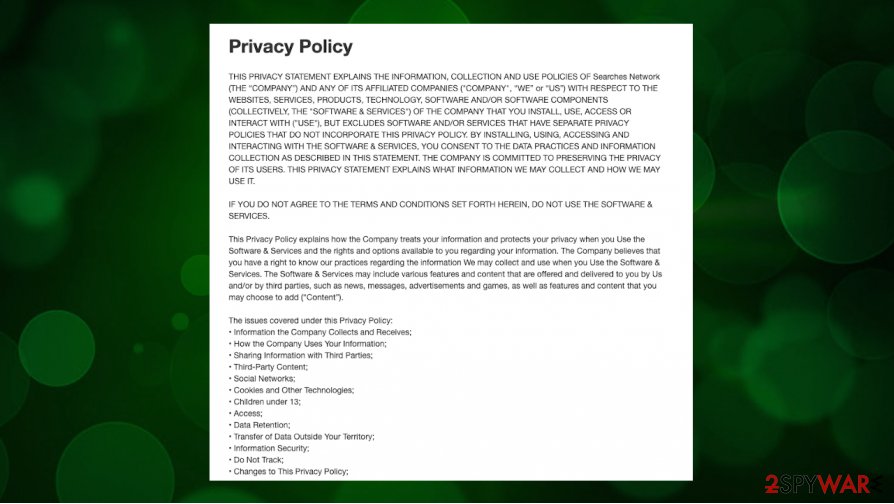Searches.network (Free Instructions) - Removal Guide
Searches.network Removal Guide
What is Searches.network?
Searches.network – the potentially unwanted program that triggers changes to settings on the web browser, so traffic is controlled

All the changes that this Searches.network PUP makes, rely on affecting the online traffic on your Google Chrome, Internet Explorer, Safari, Mozilla Firefox browsers. Browser hijackers like this one can alter default search engine, new tab, new window settings, and preferences. But also, these PUPs tend to rely on ad-tracking methods and record information about your habits online. It can trigger various processes and allow other threats to come on the PC, so clear the machine as soon as you can.
| Name | Searches.network |
|---|---|
| Type | Browser hijacker/ redirect virus |
| Issues | The program creates issues with performance when online traffic is rerouted through all those advertising platforms and third-party sites. Internet speed suffers significantly when multiple windows get opened from one click on a shady pop-up or redirect |
| Distribution | Freeware installations when the user skips through important steps can result in PUP downloads. Also, the existence of another cyber threat also can lead to silent installations of PUPs |
| Elimination | You should remove Searches.network from the machine when you encounter changes made to settings on the machine. Rely on anti-malware tools, so the system can get cleared fully |
| Repair | Try to recover system functions and needed files with the help of FortectIntego or a similar repair application |
Searches.network is the search hijacker identical to Searchmine.net, ad other versions that belong to the WebCrawler family or group using the particular webcrawler.com search engine. These redirect viruses tend to trigger installs of additional browser extensions or programs, so PUPs can become more persistent and intrusive.[2]
You should consider and look out for the browser hijacker symptoms and make sure to remove all the intruders that might be related to Searches.network or another PUP. You need to pay attention to changes that indicate PUP existence on your device directly:
- changed default search engine;
- altered new tab and new windows settings;
- browser-based applications added behind your back;
- programs installed without your permission.
If any of these occur, you can know that redirects and pop-ups are not the ones that you need to fight. You need to properly remove Searches.network that is controlling all the procedures by running in the background. You cannot find the program yourself that easily, so run SpyHunter 5Combo Cleaner or Malwarebytes and try to eliminate this intruder.

Searches.network removal is especially important when the PUP managed to run for a longer period. This browser hijacker is the one that can get installed behind your back, so you need to check more places on the system. Anti-malware tools can do that for you, even though calling this PUP a virus is not correct.
Searches.network is potentially unwanted and intrusive, but besides the data tracking and third-party involvement, it is not harmful. You can see that the Privacy Policy of the site states that there are various relations and communication between the site and third parties, so information recorded by the search engine might end up in other hands. This is why experts[3] call these PUPs shady.

Misleading updaters and promotional sites lead to PUP installs
You might find promotional ads or redirects to free download sites that provide this program as a useful search engine and fall for the misleading content campaigns. Unfortunately, there are particular fake Flash Player installers or Adobe product promotional pages that lead to the installation of hijackers, different search engines, or system tools.
You need to rely on official developer sources and use pages that can be trusted as the main source of your programs, so you can be sure that there are no additional pieces installed besides your wanted freeware program. You can choose Advanced or Custom installation options when you download anything from the internet, so the procedure is controlled by you only. You can see the full list of pre-bundled programs and remove any suspicious ones.
The system cleaning procedure can help eliminate Searches.network virus completely
Even though this program is not an application that could be categorized as a malicious piece of software, you need to remove Searches.network with the help of anti-malware tools. This intruder can appear on Windows and on macOS devices, so automatic tools designed to clear threats to give the advantage for you.
Searches.network removal procedure should also include direct web browser resetting because some of the applications end up installed automatically and can interfere with the persistence of the PUP itself. You can find additional tips below for these steps of resetting web browsers.
You may remove virus damage with a help of FortectIntego. SpyHunter 5Combo Cleaner and Malwarebytes are recommended to detect potentially unwanted programs and viruses with all their files and registry entries that are related to them.
Getting rid of Searches.network. Follow these steps
Uninstall from Windows
The system can get cleared properly when you remove Searches.network
Instructions for Windows 10/8 machines:
- Enter Control Panel into Windows search box and hit Enter or click on the search result.
- Under Programs, select Uninstall a program.

- From the list, find the entry of the suspicious program.
- Right-click on the application and select Uninstall.
- If User Account Control shows up, click Yes.
- Wait till uninstallation process is complete and click OK.

If you are Windows 7/XP user, proceed with the following instructions:
- Click on Windows Start > Control Panel located on the right pane (if you are Windows XP user, click on Add/Remove Programs).
- In Control Panel, select Programs > Uninstall a program.

- Pick the unwanted application by clicking on it once.
- At the top, click Uninstall/Change.
- In the confirmation prompt, pick Yes.
- Click OK once the removal process is finished.
Delete from macOS
Follow the guide and eliminate Searches.network from your system
Remove items from Applications folder:
- From the menu bar, select Go > Applications.
- In the Applications folder, look for all related entries.
- Click on the app and drag it to Trash (or right-click and pick Move to Trash)

To fully remove an unwanted app, you need to access Application Support, LaunchAgents, and LaunchDaemons folders and delete relevant files:
- Select Go > Go to Folder.
- Enter /Library/Application Support and click Go or press Enter.
- In the Application Support folder, look for any dubious entries and then delete them.
- Now enter /Library/LaunchAgents and /Library/LaunchDaemons folders the same way and terminate all the related .plist files.

Remove from Microsoft Edge
Delete unwanted extensions from MS Edge:
- Select Menu (three horizontal dots at the top-right of the browser window) and pick Extensions.
- From the list, pick the extension and click on the Gear icon.
- Click on Uninstall at the bottom.

Clear cookies and other browser data:
- Click on the Menu (three horizontal dots at the top-right of the browser window) and select Privacy & security.
- Under Clear browsing data, pick Choose what to clear.
- Select everything (apart from passwords, although you might want to include Media licenses as well, if applicable) and click on Clear.

Restore new tab and homepage settings:
- Click the menu icon and choose Settings.
- Then find On startup section.
- Click Disable if you found any suspicious domain.
Reset MS Edge if the above steps did not work:
- Press on Ctrl + Shift + Esc to open Task Manager.
- Click on More details arrow at the bottom of the window.
- Select Details tab.
- Now scroll down and locate every entry with Microsoft Edge name in it. Right-click on each of them and select End Task to stop MS Edge from running.

If this solution failed to help you, you need to use an advanced Edge reset method. Note that you need to backup your data before proceeding.
- Find the following folder on your computer: C:\\Users\\%username%\\AppData\\Local\\Packages\\Microsoft.MicrosoftEdge_8wekyb3d8bbwe.
- Press Ctrl + A on your keyboard to select all folders.
- Right-click on them and pick Delete

- Now right-click on the Start button and pick Windows PowerShell (Admin).
- When the new window opens, copy and paste the following command, and then press Enter:
Get-AppXPackage -AllUsers -Name Microsoft.MicrosoftEdge | Foreach {Add-AppxPackage -DisableDevelopmentMode -Register “$($_.InstallLocation)\\AppXManifest.xml” -Verbose

Instructions for Chromium-based Edge
Delete extensions from MS Edge (Chromium):
- Open Edge and click select Settings > Extensions.
- Delete unwanted extensions by clicking Remove.

Clear cache and site data:
- Click on Menu and go to Settings.
- Select Privacy, search and services.
- Under Clear browsing data, pick Choose what to clear.
- Under Time range, pick All time.
- Select Clear now.

Reset Chromium-based MS Edge:
- Click on Menu and select Settings.
- On the left side, pick Reset settings.
- Select Restore settings to their default values.
- Confirm with Reset.

Remove from Mozilla Firefox (FF)
Remove dangerous extensions:
- Open Mozilla Firefox browser and click on the Menu (three horizontal lines at the top-right of the window).
- Select Add-ons.
- In here, select unwanted plugin and click Remove.

Reset the homepage:
- Click three horizontal lines at the top right corner to open the menu.
- Choose Options.
- Under Home options, enter your preferred site that will open every time you newly open the Mozilla Firefox.
Clear cookies and site data:
- Click Menu and pick Settings.
- Go to Privacy & Security section.
- Scroll down to locate Cookies and Site Data.
- Click on Clear Data…
- Select Cookies and Site Data, as well as Cached Web Content and press Clear.

Reset Mozilla Firefox
If clearing the browser as explained above did not help, reset Mozilla Firefox:
- Open Mozilla Firefox browser and click the Menu.
- Go to Help and then choose Troubleshooting Information.

- Under Give Firefox a tune up section, click on Refresh Firefox…
- Once the pop-up shows up, confirm the action by pressing on Refresh Firefox.

Remove from Google Chrome
The particular browser should get reset to default, so Google Chrome works properly and none of the Searches.network-related apps
Delete malicious extensions from Google Chrome:
- Open Google Chrome, click on the Menu (three vertical dots at the top-right corner) and select More tools > Extensions.
- In the newly opened window, you will see all the installed extensions. Uninstall all the suspicious plugins that might be related to the unwanted program by clicking Remove.

Clear cache and web data from Chrome:
- Click on Menu and pick Settings.
- Under Privacy and security, select Clear browsing data.
- Select Browsing history, Cookies and other site data, as well as Cached images and files.
- Click Clear data.

Change your homepage:
- Click menu and choose Settings.
- Look for a suspicious site in the On startup section.
- Click on Open a specific or set of pages and click on three dots to find the Remove option.
Reset Google Chrome:
If the previous methods did not help you, reset Google Chrome to eliminate all the unwanted components:
- Click on Menu and select Settings.
- In the Settings, scroll down and click Advanced.
- Scroll down and locate Reset and clean up section.
- Now click Restore settings to their original defaults.
- Confirm with Reset settings.

Delete from Safari
Remove unwanted extensions from Safari:
- Click Safari > Preferences…
- In the new window, pick Extensions.
- Select the unwanted extension and select Uninstall.

Clear cookies and other website data from Safari:
- Click Safari > Clear History…
- From the drop-down menu under Clear, pick all history.
- Confirm with Clear History.

Reset Safari if the above-mentioned steps did not help you:
- Click Safari > Preferences…
- Go to Advanced tab.
- Tick the Show Develop menu in menu bar.
- From the menu bar, click Develop, and then select Empty Caches.

After uninstalling this potentially unwanted program (PUP) and fixing each of your web browsers, we recommend you to scan your PC system with a reputable anti-spyware. This will help you to get rid of Searches.network registry traces and will also identify related parasites or possible malware infections on your computer. For that you can use our top-rated malware remover: FortectIntego, SpyHunter 5Combo Cleaner or Malwarebytes.
How to prevent from getting browser hijacker
Access your website securely from any location
When you work on the domain, site, blog, or different project that requires constant management, content creation, or coding, you may need to connect to the server and content management service more often. The best solution for creating a tighter network could be a dedicated/fixed IP address.
If you make your IP address static and set to your device, you can connect to the CMS from any location and do not create any additional issues for the server or network manager that needs to monitor connections and activities. VPN software providers like Private Internet Access can help you with such settings and offer the option to control the online reputation and manage projects easily from any part of the world.
Recover files after data-affecting malware attacks
While much of the data can be accidentally deleted due to various reasons, malware is one of the main culprits that can cause loss of pictures, documents, videos, and other important files. More serious malware infections lead to significant data loss when your documents, system files, and images get encrypted. In particular, ransomware is is a type of malware that focuses on such functions, so your files become useless without an ability to access them.
Even though there is little to no possibility to recover after file-locking threats, some applications have features for data recovery in the system. In some cases, Data Recovery Pro can also help to recover at least some portion of your data after data-locking virus infection or general cyber infection.
- ^ Ad revenue. Wikipedia. The free encyclopedia.
- ^ What Is a PUP (Potentially Unwanted Program)?. Lifewire. Internet, networking, and security.
- ^ Virusai. Virusai. Spyware related news.























